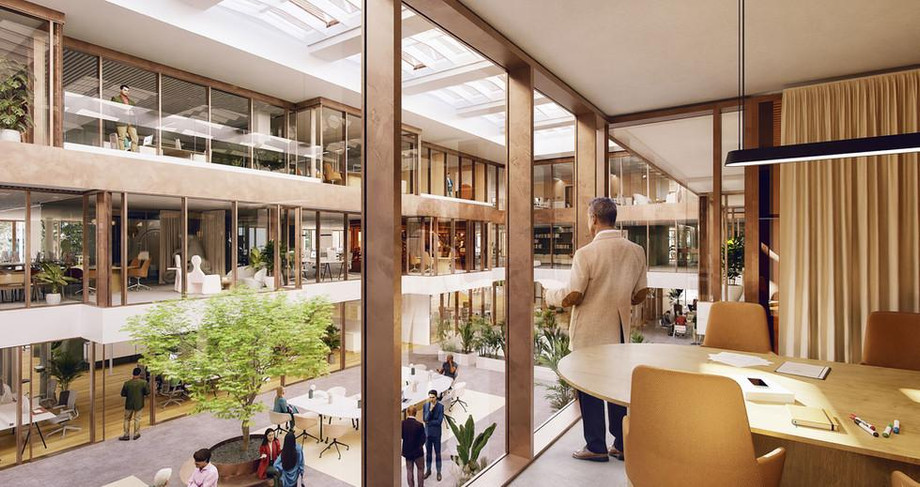The modern office is not just a place to work; it's a reflection of a company's culture, values, and commitment to its employees. In recent years, there has been a significant shift in the way offices are designed. Today's modern office design is about fostering collaboration, promoting employee well-being, and inspiring creativity. In this article, we will explore the evolving landscape of modern office design and its impact on productivity, satisfaction, and the overall work environment.
The Shift to Open and Collaborative Spaces
One of the most noticeable changes in modern office design is the shift from traditional cubicles and closed offices to open and collaborative spaces. The idea is to break down physical barriers, encourage interaction among employees, and facilitate the free flow of ideas. Open floor plans, shared workspaces, and communal areas have become staples of modern office design.
Open spaces promote collaboration, leading to increased creativity and better problem-solving. It also creates a sense of equality among team members, fostering a culture of inclusivity. However, it's essential to balance open spaces with areas for private work to accommodate different working styles and tasks effectively.
Flexible and Adaptable Layouts
Modern offices prioritize flexibility and adaptability. With the rise of remote work and the need for hybrid work models, office design has evolved to accommodate changing needs. Furniture and workspace arrangements are designed to be easily reconfigured, allowing for various setups, such as hot desking, collaborative workstations, or quiet zones.
Flexible layouts provide employees with the freedom to choose the best environment for their tasks. For example, team meetings can take place in open collaboration areas, while focused work can be done in quiet, individual spaces. This adaptability is a critical factor in enhancing employee satisfaction and productivity.
Biophilic Design and Wellness
Modern office design increasingly incorporates elements of biophilic design to connect employees with nature and improve their well-being. Incorporating natural elements, such as indoor plants, natural lighting, and materials like wood and stone, can reduce stress and boost creativity and productivity. Biophilic design also includes outdoor spaces, rooftop gardens, and green walls, creating a pleasant and healthy work environment.
Wellness is another crucial aspect of contemporary office design. Wellness rooms for relaxation, meditation, and exercise, along with ergonomic furniture, contribute to employee health and satisfaction. These features recognize the importance of mental and physical well-being in the workplace and foster a positive work culture.
Technology Integration
The modern office is inherently tech-savvy. It integrates advanced technology to enhance productivity and connectivity. The design includes features such as smart lighting, temperature control, and occupancy sensors to optimize energy efficiency and create a comfortable workspace.
Digital collaboration tools, interactive whiteboards, and video conferencing facilities are also incorporated to support remote and hybrid work models. High-speed internet and well-equipped meeting rooms are now prerequisites for efficient modern offices.
Cultural Identity and Brand Expression
Modern office design often reflects the cultural identity and brand expression of the company. It's about creating a visual identity that represents the company's mission and values. Design elements, color schemes, and branding can be seen throughout the office space, reinforcing the company's culture and providing a sense of belonging for employees.
Furthermore, incorporating artwork and installations can add a creative touch to the workspace, making it visually stimulating and inspiring. Art and design elements can spark conversations, encourage creativity, and reflect the company's personality.
Sustainability and Eco-Friendly Practices
Sustainability is a fundamental aspect of modern office design. Green building materials, energy-efficient lighting, and environmentally conscious practices are integrated into the design. Office spaces are designed to minimize waste and reduce energy consumption. Many modern offices also incorporate recycling and composting areas to promote responsible environmental practices.
Sustainable design not only benefits the planet but also enhances the well-being of employees. Natural lighting, improved air quality, and reduced noise pollution contribute to a healthier and more productive work environment.
The Hybrid Work Model
The global shift towards hybrid work models, allowing employees to work both in the office and remotely, has a significant impact on modern office design. Office spaces now need to be versatile and supportive of this new work dynamic. This means providing the necessary technology and amenities to accommodate remote workers while maintaining a vibrant in-office experience for those who choose to come in.
For more info:-





Comments